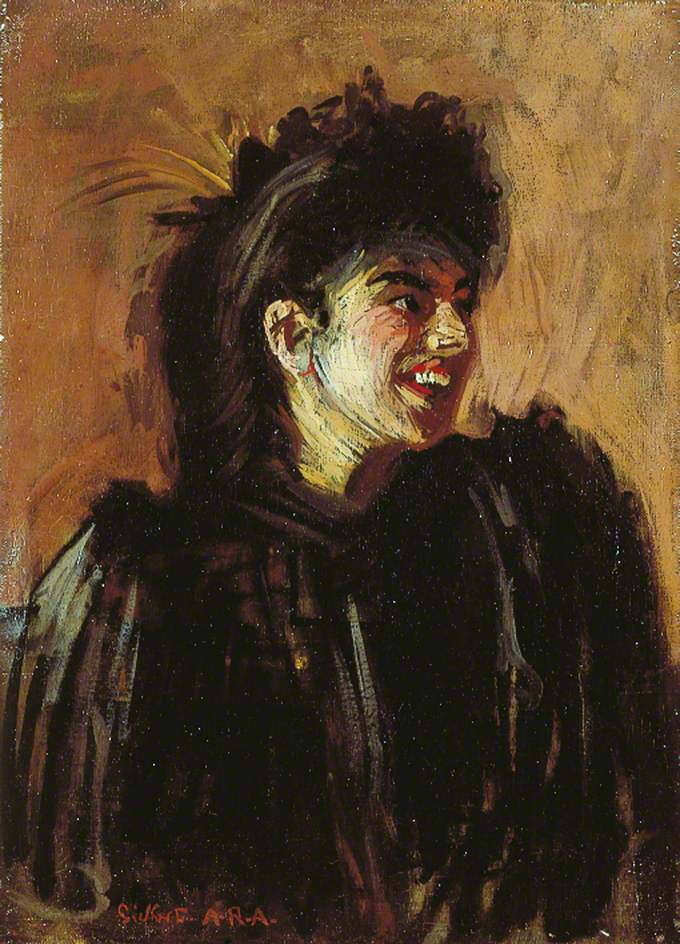Probably the most well known example of Sickert's relationship with photography is his portrait of King Edward the VII, the cropping being probably something he learnt from Degas. As artists began to respond to the photographic image, one of the most interesting issues was how we were reminded of how composed paintings were. One of Yiadom-Boakye's chosen artists, Lisa Brice, is I sense very aware of Sickert, but is now taking the concept of the frame and how it cuts into reality, in another direction, this time using it as a way to reconnect with images of women as framed by men in paintings. She is not like Sickert, casting a photograph into paint, but re-casting the roles of women who inhabit older painting, this time giving them a much greater agency in the image. An agency I personally recognise that can be derived from the act of smoking, the taking up of which at one time, I felt to be an anti-authoritarian snub to my father. It's interesting how easily personal history interweaves itself into the way we find meaning in our experiences. We might love our fathers, but we need to take actions that ensure we don't end up living life under their shadow and I sense that is partly what Brice is saying in these images, she loves painting's history, but needs to re-cast it as something she owns.
Yiadom-Boakye's imaginary portrait drawings, 'Sunbird 2' and 'Sunbird 3' are direct responses to Sickert's painting. At the core of my fascination with her work, is the fact that her portraits are imaginary. She forces us to confront what I think is a central issue in our understanding of portraiture, how much of our understanding of it is due to our obsession with what someone looks like and how much is it a reflection of how we read human beings as types. If, she suggests, an artist is to give life to her subject, she has to first of all give life to the materials used to depict that subject and if that is successfully accomplished, this new life, will be read and responded to as any other human being. Sometimes understood as a stereotype, or cliché and at other times as a particular individual that you can have empathy with; the reading is in the power of the beholder.
Yiadom-Boakye's hand is a simple solid, the charcoal is blocked in and heavily worked with a rubber. The charcoal is pushed into the paper, using it feels like a good sized block of compressed charcoal, as opposed to a willow charcoal. Kramer's is softer and more delicate. He uses willow charcoal, smoothing out his tonal changes by smudging with his fingers and making highlights with a sharpened rubber. He is feeling for the form of the hand as an extension of the expression of the face, whilst in comparison Yiadom-Boakye's hand is more generic, perhaps even more mechanical, definitely a hand designed to punch more than to express a continuation of the 'read' of the face. Both artists are seeking some sort of authentic communication, trying to express something about what it is to be part of a community that has historically for one reason or another been overlooked. As people from my own family, came as Jews to the UK in the late nineteenth century, I am very aware of the pogroms that Kramer is asking us to remember. His family lived not far from where I live in Chapeltown, which was then home to immigrant families from eastern Europe and Ireland, as it is now for people from the West Indies and other parts of the old British Commonwealth. Kramer wrote that when he was looking at his subject, he saw both its physical appearance and its spiritual manifestation. His struggle, he claimed, was to escape physical appearances and to paint the subject's spiritual form, an idea that was very much of his time, being central to expressionist thinking and deeply influenced by Theosophy. His struggle to find a form of expression that could both elevate the human spirit and remind us of a people's history, give his images a particular authenticity, that can find parallels with Yiadom-Boakye's work. She is also concerned to address a history of a people's representation, or perhaps more accurately their non-representation and in giving form to invented lives, she peoples the walls of the galleries she exhibits in with the portraits that have historically been missing.
Many portraits over time lose their associations with particular human beings and by the time we get to see them, the name of who was depicted has long disappeared. But we are still fascinated by the image of a human being, and perhaps once a portrait is unanchored from the particularities of a name, we can much more easily inhabit the image in our imagination.


.jpg)

































